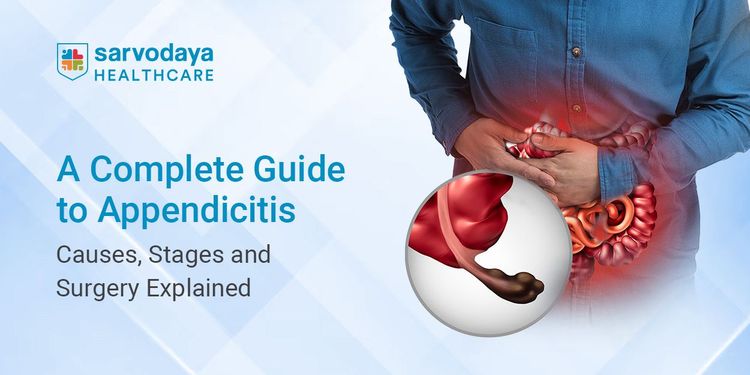Appendicitis is a common abdominal emergency faced by people across all age groups. It occurs when the appendix, a small pouch connected to the large intestine, becomes inflamed and filled with pus. If left untreated, this condition can lead to rupture, which can cause life-threatening complications. Timely diagnosis and treatment play a crucial role in preventing such outcomes and ensuring a safe recovery.
In this blog, we discuss the causes of appendicitis, its various types, the four stages of appendicitis, symptoms, treatment options, including appendicitis removal surgery, and what to expect during recovery.
Understanding Appendicitis
The appendix is a narrow tube, usually measuring around 5 to 10 cm in standard size. It has no essential function in the human body, but when it becomes blocked or infected, it can cause severe abdominal pain. This inflammation is medically known as appendicitis.
If left untreated, appendicitis can progress through the four stages of appendicitis, eventually leading to rupture. The treatment approach depends on the stage at which the condition is diagnosed and whether complications, such as perforation or abscess formation, have developed.
Causes of Appendicitis
The exact cause of appendicitis may vary, but in most cases, it develops due to a blockage in the appendix. This blockage leads to inflammation, infection, and sometimes rupture.
Some of the most common causes include:
- Blockage of the Appendix: Often caused by hardened stool, foreign bodies, or tumours.
- Infections: Viral, bacterial, or gastrointestinal infections can trigger swelling of the appendix.
- Enlarged Lymph Nodes: Swollen lymph tissue inside the appendix can obstruct it.
- Genetic and Lifestyle Factors: Certain genetic traits or poor dietary habits may increase risks.
Read More- Life After Appendix Removal: Benefits of Robotic Surgery for Appendicitis
Types of Appendicitis
Appendicitis can be classified into two main types depending on its severity and progression.
The two main types are:
Acute Appendicitis- The most common form of the disease.
- It develops suddenly with severe pain and requires urgent appendicitis removal surgery.
- If left untreated, it can progress rapidly and result in rupture.
- A less common form where symptoms are mild and occur over a more extended period.
- Pain may come and go, making it harder to diagnose.
- Although less severe, it can still lead to complications if ignored.
Treatment for both types generally involves surgery, which can be performed either as open surgery or through laparoscopic methods.
Stages of Appendicitis
The progression of appendicitis can be divided into four stages, each with increasing severity.
Here are the stages explained:
- Early/Initial Stage: Mild inflammation develops, accompanied by pain around the navel. Symptoms may not be particular.
- Suppurative Stage: Pus begins to form inside the appendix, and pain shifts to the lower right abdomen.
- Gangrenous Stage: The appendix tissue starts to die due to poor blood flow, increasing the risk of rupture.
- Perforated Stage: The appendix bursts, releasing pus and infectious material into the abdomen, which can lead to peritonitis.
At advanced stages, emergency appendicitis removal surgery is the only option to prevent life-threatening complications.
Treatment of Appendicitis
The mainstay of treatment is appendicitis removal surgery, which is highly effective and safe when performed by an experienced surgeon.
Depending on the patient’s condition, two primary appendicitis surgery types are available:
Open Appendicectomy:- A single appendicitis surgery incision is made in the abdomen.
- Often used in complicated or advanced cases.
Appendicitis Surgery Laparoscopic:
- Several small incisions are made for inserting a camera and instruments.
- Offers quicker healing, less pain, and fewer scars.
- An advanced form of laparoscopic surgery performed using robotic assistance.
- Provides greater precision, minimal tissue damage, and faster recovery.
- Available at select advanced hospitals with specialised expertise.
Additional details about the procedure:
- Appendicitis surgery time is usually between 30 and 60 minutes.
- Surgery is done under general anaesthesia.
- Hospital stay ranges from 1 to 3 days, depending on recovery.
In rare cases where the appendix is less inflamed, antibiotics may be given, but this is not a permanent solution.
Read More- Appendix Surgery Cost in India: Complete Guide to Treatment & Recovery
Recovery and Post-Surgery Care
Recovery after appendicitis surgery depends on the type of procedure performed and the patient’s overall health. With laparoscopic appendicitis surgery, healing is typically faster compared to open surgery. In advanced cases where robotic appendicitis surgery is performed, patients can expect even less discomfort, a quicker return to daily activities, and minimal scarring.
Here are the key aspects of recovery:
- Appendicitis Surgery Recovery Time:
- 1–2 weeks for laparoscopic surgery.
- 2–4 weeks for open surgery.
- 1 week or less for robotic surgery in many cases.
- Wound Care: Keep the surgical site clean and follow all hospital instructions.
- Dietary Changes: Begin with soft foods and gradually reintroduce a regular diet.
- Activity Restrictions: Avoid heavy lifting or strenuous exercise until cleared by the doctor.
Conclusion
Appendicitis is a serious condition that requires quick diagnosis and prompt treatment. The gold standard for managing this illness remains appendicitis removal surgery, which is safe and effective when performed by an experienced surgeon. With modern techniques like laparoscopic appendicitis surgery, patients can expect quicker recovery and fewer complications.
At Sarvodaya Hospital, Faridabad, patients have access to advanced facilities, a team of highly skilled general surgeons, and state-of-the-art technology to ensure the best possible outcomes. The hospital not only provides expert care for appendicitis but also offers preventive consultations to detect issues early and avoid complications. Sarvodaya Hospital also offers robotic appendicitis surgery, a cutting-edge technique that ensures greater precision, smaller incisions, faster recovery and minimal scarring. This advanced approach reduces pain, lowers the risk of complications, and enables patients to return to their normal lives with greater confidence. Choosing a trusted general surgery hospital in Faridabad, Delhi NCR, ensures that patients receive safe, reliable, and high-quality care throughout their treatment journey.
By being aware of the causes of appendicitis, recognising symptoms early, and seeking care at the right time, patients can recover quickly and return to everyday life.



















